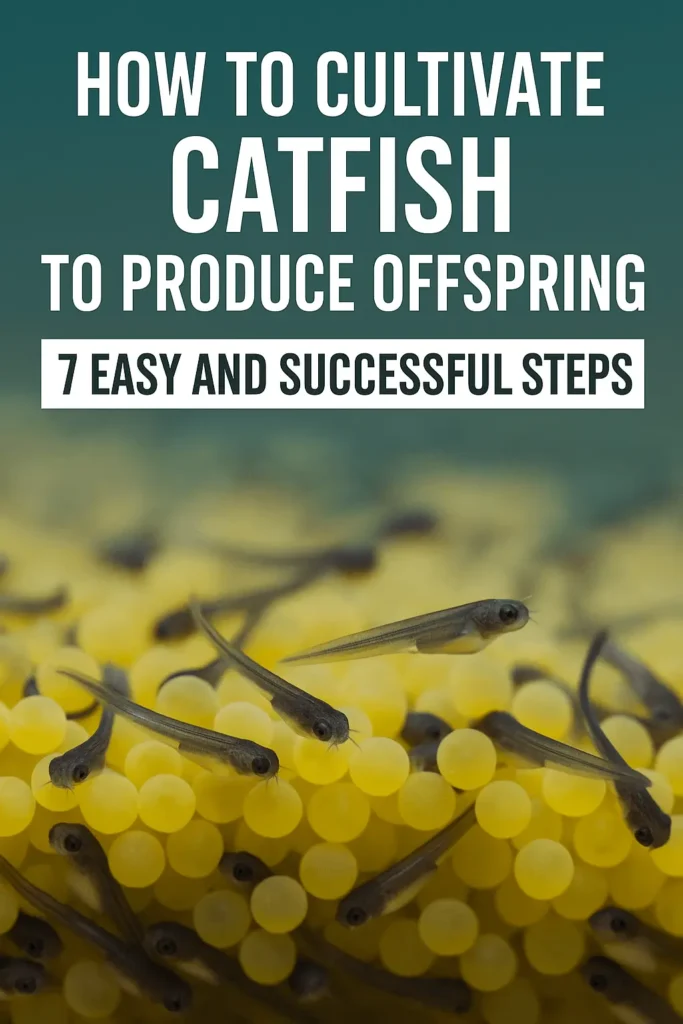How to cultivate catfish to produce offspring is a crucial skill for anyone serious about the aquaculture industry. With the right techniques, you can produce a large number of high-quality catfish fry. In this article, we will guide you through a step-by-step process to successfully breed catfish.
Why Catfish Farming is Highly Profitable
Catfish are one of the fastest-growing and easiest freshwater fish to farm. The high market demand makes catfish farming a highly lucrative business. However, mastering how to cultivate catfish to produce offspring properly is key to your success.
7 Easy Steps to Cultivate Catfish to Produce Offspring
1. Choose High-Quality Broodstock
Selecting healthy broodstock is the first and most critical step. Ensure that:
- Broodstock are 1–1.5 years old.
- Their body size is large and proportional.
- They move actively with no injuries.
- They have previously spawned or are ready to spawn.
Tip:
High-quality broodstock directly impact the success of catfish breeding for spawning and ensure healthier and stronger fry for your farm.
2. Prepare the Breeding Pond
Ideal breeding pond requirements:
- Minimum size of 2 x 3 meters.
- Water depth between 40–50 cm.
- Good water circulation.
- Install spawning mats (kakaban) made from fibers or fine nets.
Note:
Proper pond preparation ensures a clean and stress-free environment, which is crucial for successful catfish breeding for spawning activities.
3. Broodstock Selection and Preparation
Before mating, select broodstock based on these signs:
- Female: Swollen belly, pinkish genital opening.
- Male: Protruding, reddish genital organ.
These preparatory steps are vital, especially for farmers engaging in beginner catfish farming, to increase spawning success rates.
4. Natural Spawning Techniques
Natural spawning is the most popular technique:
- Place one male and one female broodstock in the breeding pond in the late afternoon.
- Allow natural mating to occur overnight.
- By the next morning, the eggs will stick to the spawning mats.
Tip:
Minimizing stress during this phase is crucial for higher fertilization rates and successfully moving forward to how to hatch catfish eggs efficiently.
5. Egg Handling and Hatching
After the eggs are laid:
- Remove the broodstock from the pond.
- Maintain water temperature at 26–28°C.
- Provide aeration to ensure sufficient oxygen levels.
- Eggs will hatch within 24–36 hours.
Important:
How to hatch catfish eggs correctly is critical at this point. Make sure you prevent fungal infections by adding safe treatments like methylene blue when necessary to safeguard the embryos.
6. Caring for Catfish Larvae
After hatching:
- Larvae do not need feeding for the first 2–3 days (they absorb yolk sac).
- Afterward, feed them with natural live food like infusoria or artemia.
- Keep water clean and stable.
Note:
At this early stage of beginner catfish farming, careful larval management will directly influence the health and growth rate of your future fingerlings.
7. Transfer to Nursery Pond
When larvae are 2–3 weeks old:
- Move them to the nursery pond.
- Make sure the new pond is sterilized.
- Gradually introduce additional food types.
Gradual acclimation to the new environment is important to maintain health and minimize stress, especially for newcomers to beginner catfish farming operations.
Common Problems During Catfish Breeding and Their Solutions
| Problem | Solution |
|---|---|
| Eggs not hatching | Maintain stable water temperature, use aeration. |
| Eggs develop fungus | Apply methylene blue treatment. |
| Broodstock not spawning | Check broodstock maturity, replace if needed. |
Conclusion
Mastering how to cultivate catfish to produce offspring requires precision, patience, and a solid understanding of catfish biology. By following the steps outlined above, you can significantly improve your chances of producing high-quality catfish fry.
Start with selecting the best broodstock, properly prepare the breeding pond, allow natural spawning, and carefully care for the larvae. With these strategies, you’ll enjoy abundant and healthy catfish production!
FAQ on How to Cultivate Catfish to Produce Offspring
Q: How long does catfish breeding take?
A: The spawning and hatching process typically takes 1–2 days.
Q: When should catfish larvae start eating?
A: After 2–3 days post-hatching when the yolk sac is absorbed.
Q: Is aeration necessary during hatching?
A: Yes, aeration is crucial to maintain high oxygen levels in the water.





